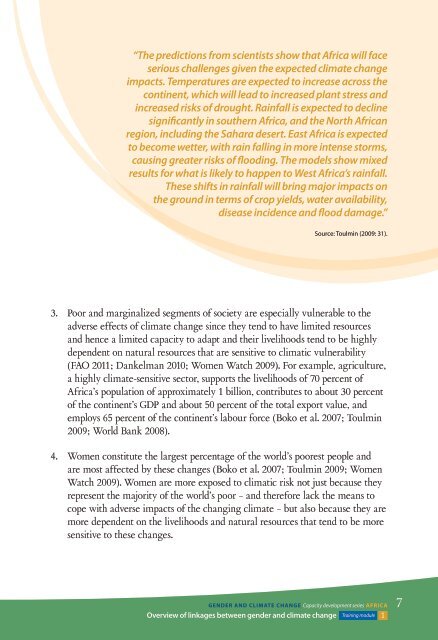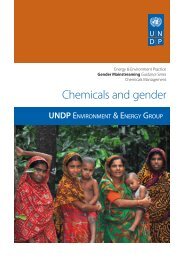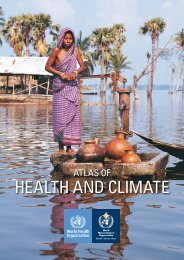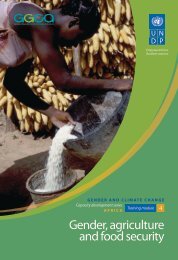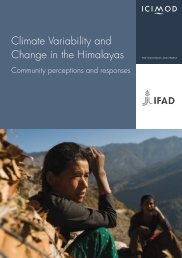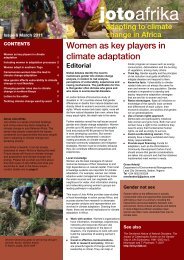Overview of linkages between gender and climate change
Overview of linkages between gender and climate change
Overview of linkages between gender and climate change
You also want an ePaper? Increase the reach of your titles
YUMPU automatically turns print PDFs into web optimized ePapers that Google loves.
“The predictions from scientists show that Africa will face<br />
serious challenges given the expected <strong>climate</strong> <strong>change</strong><br />
impacts. Temperatures are expected to increase across the<br />
continent, which will lead to increased plant stress <strong>and</strong><br />
increased risks <strong>of</strong> drought. Rainfall is expected to decline<br />
significantly in southern Africa, <strong>and</strong> the North African<br />
region, including the Sahara desert. East Africa is expected<br />
to become wetter, with rain falling in more intense storms,<br />
causing greater risks <strong>of</strong> flooding. The models show mixed<br />
results for what is likely to happen to West Africa’s rainfall.<br />
These shifts in rainfall will bring major impacts on<br />
the ground in terms <strong>of</strong> crop yields, water availability,<br />
disease incidence <strong>and</strong> flood damage.”<br />
Source: Toulmin (2009: 31).<br />
3. Poor <strong>and</strong> marginalized segments <strong>of</strong> society are especially vulnerable to the<br />
adverse effects <strong>of</strong> <strong>climate</strong> <strong>change</strong> since they tend to have limited resources<br />
<strong>and</strong> hence a limited capacity to adapt <strong>and</strong> their livelihoods tend to be highly<br />
dependent on natural resources that are sensitive to climatic vulnerability<br />
(FAO 2011; Dankelman 2010; Women Watch 2009). For example, agriculture,<br />
a highly <strong>climate</strong>-sensitive sector, supports the livelihoods <strong>of</strong> 70 percent <strong>of</strong><br />
Africa’s population <strong>of</strong> approximately 1 billion, contributes to about 30 percent<br />
<strong>of</strong> the continent’s GDP <strong>and</strong> about 50 percent <strong>of</strong> the total export value, <strong>and</strong><br />
employs 65 percent <strong>of</strong> the continent’s labour force (Boko et al. 2007; Toulmin<br />
2009; World Bank 2008).<br />
4. Women constitute the largest percentage <strong>of</strong> the world’s poorest people <strong>and</strong><br />
are most affected by these <strong>change</strong>s (Boko et al. 2007; Toulmin 2009; Women<br />
Watch 2009). Women are more exposed to climatic risk not just because they<br />
represent the majority <strong>of</strong> the world’s poor – <strong>and</strong> therefore lack the means to<br />
cope with adverse impacts <strong>of</strong> the changing <strong>climate</strong> – but also because they are<br />
more dependent on the livelihoods <strong>and</strong> natural resources that tend to be more<br />
sensitive to these <strong>change</strong>s.<br />
Gender <strong>and</strong> Climate Change Capacity development series Afric a<br />
<strong>Overview</strong> <strong>of</strong> <strong>linkages</strong> <strong>between</strong> <strong>gender</strong> <strong>and</strong> <strong>climate</strong> <strong>change</strong> Training module 1<br />
7


